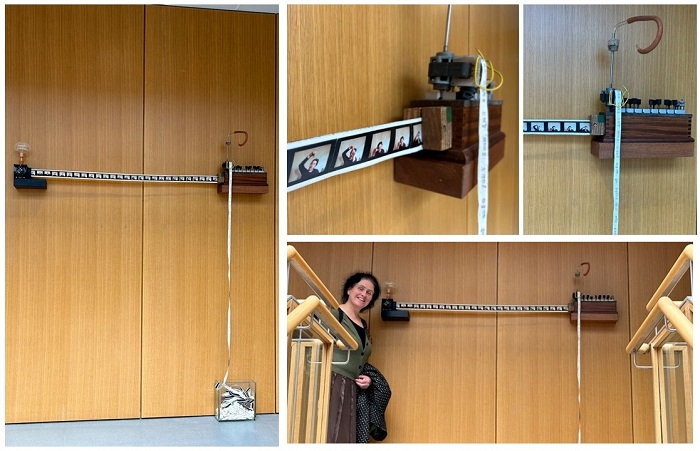Fragment of a science story from artistic residency
Lorna Donlon, the 2020/21 UCD Conway artist-in-residence produced an installation piece after conversations with Assoc. Prof. Oliver Blacque that is now on permanent display in the Institute. Lorna documented her inspiration for this creative work.
Fragment of a Story about Science
This construction came about as a result of Ollie Blacque mentioning that his father owned a video shop and using this as an analogy to explain CRISPR Cas 9 technology.
CRISPR Cas 9 technology exploits the cell’s inherent DNA repair mechanism to insert a mutated fragment of DNA, which has been introduced into the organism as part of a research experiment. Ollie described how he had watched his father repairing broken videos by cutting out damaged parts and splicing in clean versions of the same section taken from spare videos.
 Installation in situ on 1st floor landing UCD Conway Institute. Pictured Lorna Donlon, artist.
Installation in situ on 1st floor landing UCD Conway Institute. Pictured Lorna Donlon, artist.
I started thinking about viewing his zoom recording as a video tape. I was also keen to express the often frustrating invisibility of science. As technology has become more and more advanced, faster and automated, equipment has also become more streamlined, with the inner workings (or magic) all happening invisibly inside a sealed box type machine.
In this piece, we are offered a short fragment of what was a much longer story, with no context or idea of where in the story we are, when it started or when it finally ends. The fragment simply appears out of the ‘condenser’ and disappears into another machine, from which the text of the words being spoken (which we cannot hear) are emerging, spreading on a ribbon or ‘piece of string’ out into the room.
Oliver Blacque's research focuses on cilia, which are tiny, hair like projections on cells. They are involved in the movement of fluids in the body. When not functioning correctly, they can lead to cystic kidney disease, bone abnormalities and complex disorders such as Bardet-Biedl syndrome.
Social Media Links